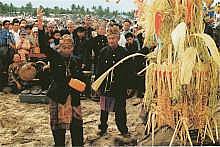| The origins of Kaul go back centuries to the time when the Melanau were animists. Today most of them are Catholics or Muslims and often adherents of the two religions in the same family live in the same house, But they still celebrate Kaul with gusto. The old animist religion may not be practiced these days but the legends live on.
The festival is celebrated on different days in the many Melanau settlements along the coast. The Tibou, the death defying 20-foot high swing, is one of the highlights of Kaul. Here youths dive from a high bamboo scaffolding and catch a swinging liana rope as it reaches the height of its arc. First one, then two and eventually eight young men hanging in a clump from the giant swing as it soars above the beach. Kaul is about more than giant swings. Itís a colourful festival with a flotilla of highly decorated boats, beach games and lots of delicious Melanau food. Traditionally, during the monsoon, the river mouths were closed. Villages would be palei or taboo for days before Kaul. No one was allowed to leave or enter, and people underwent purification ceremonies during Kaul.
At the start of Kaul, the highly decorated fishing boats move down river carrying the seraheng, a flat round basket raised on a bamboo pole. It is placed on a riverbank while the Bapa Kaul or leader of the ceremony invokes the spirits and pours water over the offerings. In the past the sick and elderly would gather by the seraheng so that the water poured on the offerings would fall on them and wash away all evil. Today the ceremony is of social rather than religious significance. After the ceremony there are games on the beach, displays of Melanau martial arts, dancing and eating. The festivities do not stop with sunset, they just move to the Melanau houses built on rivers and streams where there are cultural performances and non stop feasting. The attractive native dwellings give the fishing villages near Mukak the air of a bamboo Venice and their hospitality is legendary. Visitors to Kaul soon find why Melanau cuisine is famed throughout Sarawak. The versatile sago has become their staple food. Guests palates are surprised at the many delicious ways sago can be prepared and with the addition of seafood, visitors enjoy the appetising variety of tasty treats.
|



